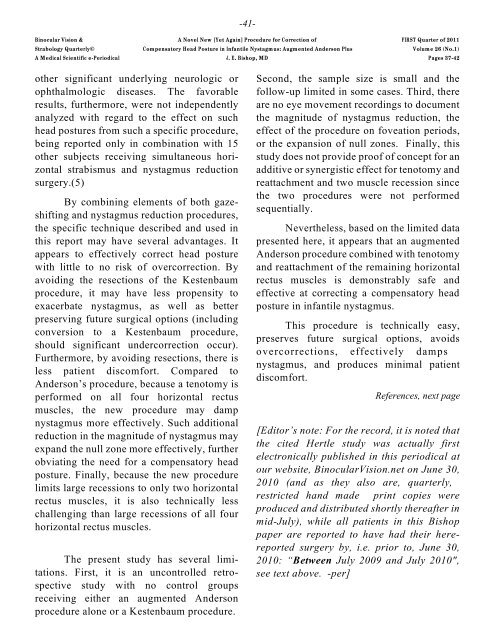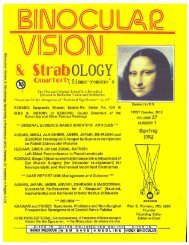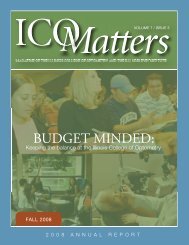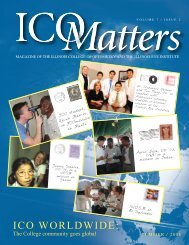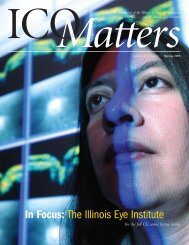Correspondence - ICO Library
Correspondence - ICO Library
Correspondence - ICO Library
You also want an ePaper? Increase the reach of your titles
YUMPU automatically turns print PDFs into web optimized ePapers that Google loves.
-41-<br />
Binocular Vision & A Novel New [Yet Again] Procedure for Correction of FIRST Quarter of 2011<br />
Strabology Quarterly© Com pensatory Head Posture in Infantile Nystagm us: Augm ented Anderson Plus Volum e 26 (No.1)<br />
A M edical Scientific e-Periodical J. E. Bishop, M D Pages 37-42<br />
other significant underlying neurologic or<br />
ophthalmologic diseases. The favorable<br />
results, furthermore, were not independently<br />
analyzed with regard to the effect on such<br />
head postures from such a specific procedure,<br />
being reported only in combination with 15<br />
other subjects receiving simultaneous horizontal<br />
strabismus and nystagmus reduction<br />
surgery.(5)<br />
By combining elements of both gazeshifting<br />
and nystagmus reduction procedures,<br />
the specific technique described and used in<br />
this report may have several advantages. It<br />
appears to effectively correct head posture<br />
with little to no risk of overcorrection. By<br />
avoiding the resections of the Kestenbaum<br />
procedure, it may have less propensity to<br />
exacerbate nystagmus, as well as better<br />
preserving future surgical options (including<br />
conversion to a Kestenbaum procedure,<br />
should significant undercorrection occur).<br />
Furthermore, by avoiding resections, there is<br />
less patient discomfort. Compared to<br />
Anderson’s procedure, because a tenotomy is<br />
performed on all four horizontal rectus<br />
muscles, the new procedure may damp<br />
nystagmus more effectively. Such additional<br />
reduction in the magnitude of nystagmus may<br />
expand the null zone more effectively, further<br />
obviating the need for a compensatory head<br />
posture. Finally, because the new procedure<br />
limits large recessions to only two horizontal<br />
rectus muscles, it is also technically less<br />
challenging than large recessions of all four<br />
horizontal rectus muscles.<br />
The present study has several limitations.<br />
First, it is an uncontrolled retrospective<br />
study with no control groups<br />
receiving either an augmented Anderson<br />
procedure alone or a Kestenbaum procedure.<br />
Second, the sample size is small and the<br />
follow-up limited in some cases. Third, there<br />
are no eye movement recordings to document<br />
the magnitude of nystagmus reduction, the<br />
effect of the procedure on foveation periods,<br />
or the expansion of null zones. Finally, this<br />
study does not provide proof of concept for an<br />
additive or synergistic effect for tenotomy and<br />
reattachment and two muscle recession since<br />
the two procedures were not performed<br />
sequentially.<br />
Nevertheless, based on the limited data<br />
presented here, it appears that an augmented<br />
Anderson procedure combined with tenotomy<br />
and reattachment of the remaining horizontal<br />
rectus muscles is demonstrably safe and<br />
effective at correcting a compensatory head<br />
posture in infantile nystagmus.<br />
This procedure is technically easy,<br />
preserves future surgical options, avoids<br />
overcorrections, effectively damps<br />
nystagmus, and produces minimal patient<br />
discomfort.<br />
References, next page<br />
[Editor’s note: For the record, it is noted that<br />
the cited Hertle study was actually first<br />
electronically published in this periodical at<br />
our website, BinocularVision.net on June 30,<br />
2010 (and as they also are, quarterly,<br />
restricted hand made print copies were<br />
produced and distributed shortly thereafter in<br />
mid-July), while all patients in this Bishop<br />
paper are reported to have had their herereported<br />
surgery by, i.e. prior to, June 30,<br />
2010: “Between July 2009 and July 2010",<br />
see text above. -per]


